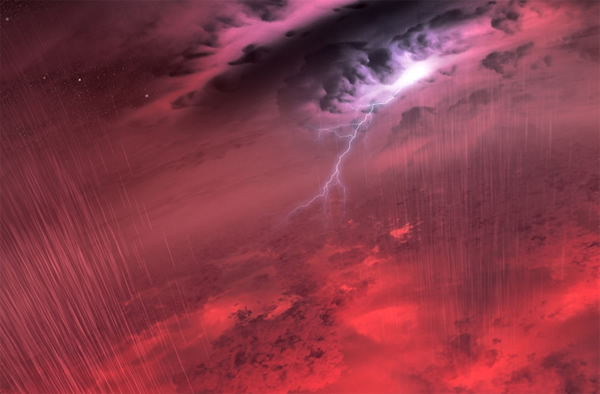Stormy Alien Atmospheres May Spark Seeds of Life
This artist's concept shows what the weather might look like on cool star-like bodies known as brown dwarfs.
As our catalog of discoveries of planets orbiting other stars spiral well over 1,000 confirmed exoplanets, the question of their life-giving qualities becomes more and more intriguing. Although astronomers are primarily hunting down Earth-sized worlds orbiting their stars in Earth-like orbits, other factors influence whether or not a given extrasolar planet has the “right stuff” for life to thrive.
In research presented at the Meeting of the Royal Astronomical Society in London on Friday, astronomers discussed the dusty, stormy atmospheres of exoplanets and brown dwarfs and how they could be hothouses for the formation of prebiotic molecules. These are organic molecules that are known to form the building blocks for life as we know it.
“The atmospheres around exoplanets and brown dwarfs form exotic clouds that, instead of being composed of water droplets, are made of dust particles made of minerals,” said astronomer Craig Stark, of the University of St. Andrews, Scotland.
The idea is that lightning storms generate copious amounts of highly charged ions and electrons, which then get stuck to dust particles, using them as miniature prebiotic chemistry factories. Of particular interest is the formation of formaldehyde, ammonia, hydrogen cyanide and the amino acid glycine, all of which underpin Earth’s biosphere.
“These charged gases are called plasmas — like those found in fluorescent lights and plasma televisions,” said Stark. “The dust can find itself immersed in the charged gases and the charged particles stick to the dust making the dust charged. The charged dust attracts onto its surface other charges from the surrounding plasma helping grow molecules on the dust surface.”
At the 223rd American Astronomical Society meeting in Washington, D.C., this week, an unrelated study by astronomers using NASA’s Spitzer Space Telescope discussed observations of brown dwarf atmospheres. The infrared observatory was able to discern patchy cloud cover in the atmospheres of these substellar objects, possibly indicating huge, swirling storms.
“As the brown dwarfs spin on their axis, the alternation of what we think are cloud-free and cloudy regions produces a periodic brightness variation that we can observe,” said astronomer Stanimir Metchev of Western University, Ontario. “These are signs of patchiness in the cloud cover.”
Although we can’t currently detect lightning storms in alien atmospheres, the churning (and often violent) atmospheric conditions of exoplanets and brown dwarfs certainly appear to be conducive to some pretty dramatic lightning bolts — events that have been observed on other planets in the solar system. And should there be a healthy mix of dusty clouds, who knows? Organic chemistry may thrive, only boosting the already high probability for life on other worlds in our galaxy.(Jan 10, 2014 01:34 PM ET // by Ian O'Neill)












